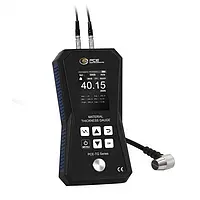
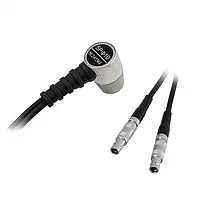
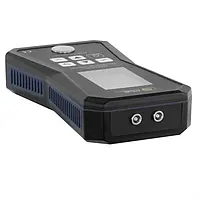
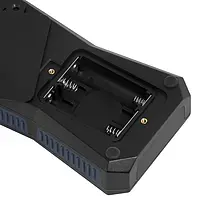
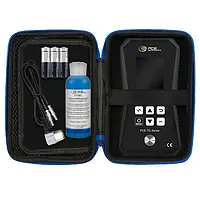
The thickness gauge can measure material thicknesses up to 225 mm. To ensure that the material thickness of a wide variety of homogeneous materials can be measured, it is possible to store the corresponding sonic velocity in the thickness gauge. For materials such as steel, aluminium, zinc, silver and gold, the appropriate sonic velocities are already stored in the device library. This means that the thickness gauge can be used universally.
Individual maximum and minimum values can be stored with the thickness gauge's limit value function. If the measured value of the test specimen is outside the limits, the thickness gauge signals this visually. If required, the thickness gauge can also provide acoustic signalling in addition to the visual display. The thickness gauge is therefore used, for example, in quality assurance and incoming goods inspection.
The thickness gauge has a data memory on which the measured values can be recorded. After a measurement process, the stored measured values can be analysed directly on the thickness gauge. The stored data is displayed graphically by the thickness gauge. In addition, each individual measuring point can be approached and read in the graphic of the thickness gauge. To simplify the analysis of the measured values, the average, the largest and smallest measured values are displayed on the thickness gauge. The thickness gauge can optionally be equipped with an ISO calibration certificate.
| Material thickness | |
| Measuring range | 1 mm ... 99.99 mm |
| Resolution | 0.01 mm |
| Accuracy | ±0.5 % v. Mw. + 0.05 mm |
| Material thickness | |
| Measuring range | 100 mm ... 225 mm |
| Resolution | 0.1 mm |
| Accuracy | ±0.5 % v. Mw. + 0.05 mm |
| Sensor | |
| Designation | PCE-TG 5M10d |
| Frequency | 5 MHz |
| Temperature range | -10 ... 60 °C |
| Measurable materials | Steel, aluminium, zinc, silver, gold, metal, plastic, ceramic, glass, other homogeneous materials |
| Minimum diameter of pipes | 30 mm |
| Additional description | Standard probe for flat materials |
| Dimensions | Ø10 mm x 23.4 mm |
| Weight | 39.5 g |
| General technical data | |
| Units | mm |
| Display type | TFT colour display |
| Display size | 2.4 inch |
| Storage medium | Internal memory |
| Memory capacity | 500 values |
| Automatic switch-off from...to | 2 ... 30 min. |
| Automatic switch-off can be deactivated | Yes |
| Sonic speed adjustable | 1000 ... 9999 m/s |
| Menu language | English (US), Chinese |
| Protection class (device) | IP52 |
| Weight | 230 g |
| Dimensions (L x W x H) | 168 x 87 x 35 mm |
| Operating conditions | 0 ... 40 °C , 0 ... 90 % r.H |
| Storage conditions | 0 ... 40 °C , 0 ... 90 % r.H |
| Accumulator/battery | 3x 1.5 V AA battery , alkaline-manganese |
| Capacity | 3000 mAh |